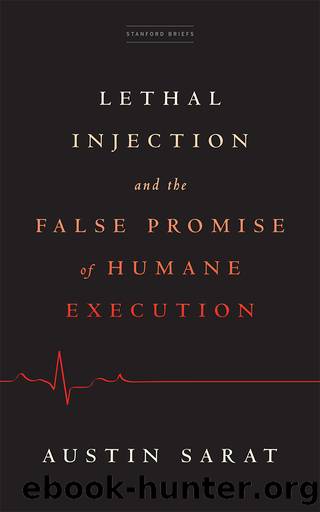Lethal Injection and the False Promise of Humane Execution by Austin Sarat

Author:Austin Sarat
Language: eng
Format: epub
Publisher: Stanford University Press
Published: 2022-02-15T00:00:00+00:00
The results of these restrictions are more or less what the states have hoped for: as states hide more of their procedures and executions, it becomes increasingly difficult to say that, or when, an execution went wrong. The implications of this lack of transparency are significant. As law professor Corinna Barrett Lain writes: âNo transparency means no public scrutiny to trigger outrage over these decision-making processes so that democracy can do its thing. And no record-keeping or other rule-making requirements mean no processes for inmates to challenge, and no records by which courts can determine whether a DOCâs decision-making was arbitrary and capricious.â35
Courts demand that evidence challenging a protocol be highly detailed and specific, so this lack of transparency around what occurs in the execution chamber greatly inhibits inmatesâ ability to challenge the conduct of their upcoming executions. Courts require inmates to produce evidence of actual errors that occurred under conditions similar to those in which they will be executed. These descriptions must be detailed accounts of an execution gone wrong in that particular state. Additionally, courts have repeatedly noted that they will not consider the ârisk of accidentâ associated with a stateâs protocol but will consider only the constitutionality of the protocol as written. As Madeira writes: âThough the state executes in the name of âthe people,â it is now increasingly impossible for citizens to learn what their state is doing. This opaqueness is dangerous to inmates and to citizens alike; it is our democratic right and privilege to decide what should be done about current lethal injection quandaries to determine where we want to draw the line, and what measures and outcomes are acceptable.â36
States prevent witnesses from viewing the entirety of the execution in several ways. One way is by closing the curtain between the execution chamber and the viewing window. In twenty-two executions between 2010 and 2020, the curtain was closed after witnesses had been ushered into the viewing room. In some instances, the curtain closure is regularly scheduled. For example, Ohioâs protocol calls for the curtain to be closed as officials assess the inmateâs status and declare death. But curtain closures, whether scheduled or unexpected, create gaps of time wherein witnesses cannot see the inmateâs reaction to the drugs.
Nebraskaâs protocol does not call for the curtain to be drawn at particular junctures in a lethal injection, but it does not proscribe curtain closures either. Much of the stateâs 2018 execution of Carey Dean Moore was hidden from witnesses by a closed curtain. The Associated Press reported that the drugs began to flow into Moore at 10:27 the morning of August 14, 2018. The prison warden closed a curtain over the mediaâs viewing window at 10:39 and did not open it again until about fourteen minutes later. Moore was declared dead at 10:47. The curtain was opened six minutes after that time to reveal Mooreâs body. It remained open for only forty seconds.37
While witnesses did see that Moore gasped as the injection took effect and that his face turned red, then purple, the majority of the process was hidden from view.
Download
This site does not store any files on its server. We only index and link to content provided by other sites. Please contact the content providers to delete copyright contents if any and email us, we'll remove relevant links or contents immediately.
| Africa | Americas |
| Arctic & Antarctica | Asia |
| Australia & Oceania | Europe |
| Middle East | Russia |
| United States | World |
| Ancient Civilizations | Military |
| Historical Study & Educational Resources |
Machine Learning at Scale with H2O by Gregory Keys | David Whiting(4183)
Never by Ken Follett(3793)
Fairy Tale by Stephen King(3220)
The Man Who Died Twice by Richard Osman(2997)
Oathbringer (The Stormlight Archive, Book 3) by Brandon Sanderson(2883)
Will by Will Smith(2793)
Rationality by Steven Pinker(2291)
The Dark Hours by Michael Connelly(2243)
Can't Hurt Me: Master Your Mind and Defy the Odds - Clean Edition by David Goggins(2228)
The Dawn of Everything: A New History of Humanity by David Graeber & David Wengrow(2122)
Friends, Lovers, and the Big Terrible Thing by Matthew Perry(2119)
Principles for Dealing With the Changing World Order: Why Nations Succeed and Fail by Ray Dalio(1974)
HBR's 10 Must Reads 2022 by Harvard Business Review(1777)
A Short History of War by Jeremy Black(1762)
Go Tell the Bees That I Am Gone by Diana Gabaldon(1687)
515945210 by Unknown(1599)
A Game of Thrones (The Illustrated Edition) by George R. R. Martin(1589)
Kingdom of Ash by Maas Sarah J(1526)
443319537 by Unknown(1470)
